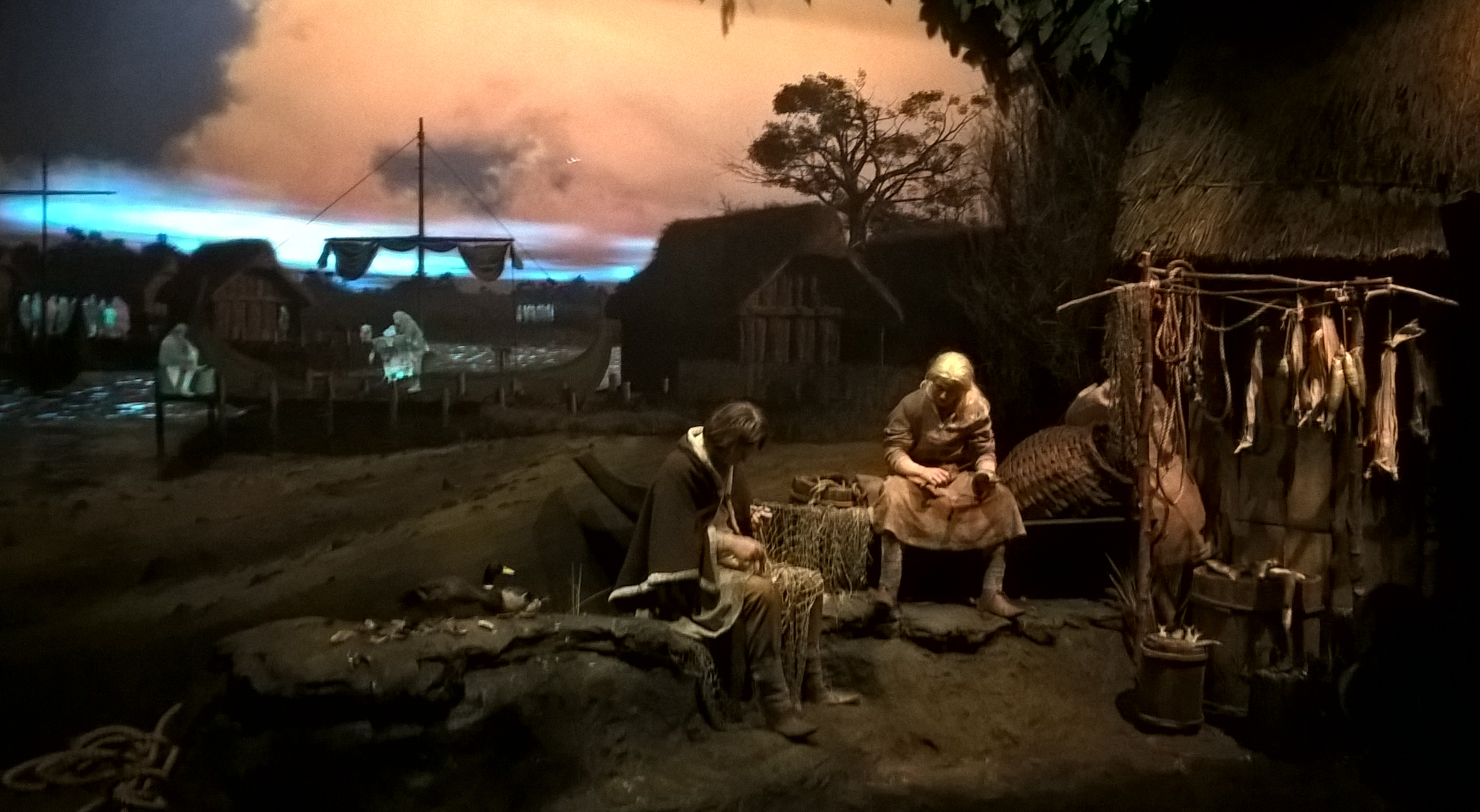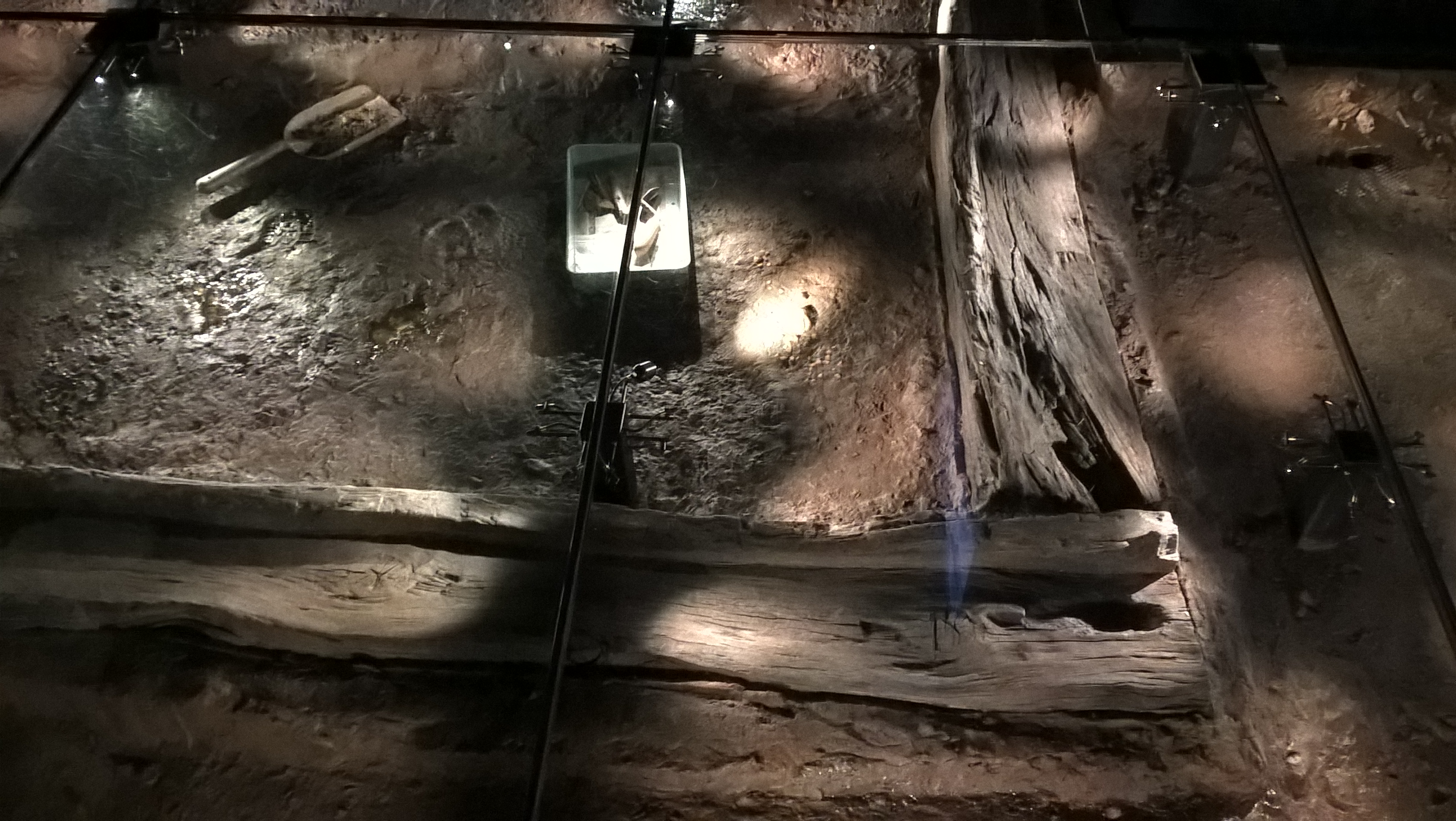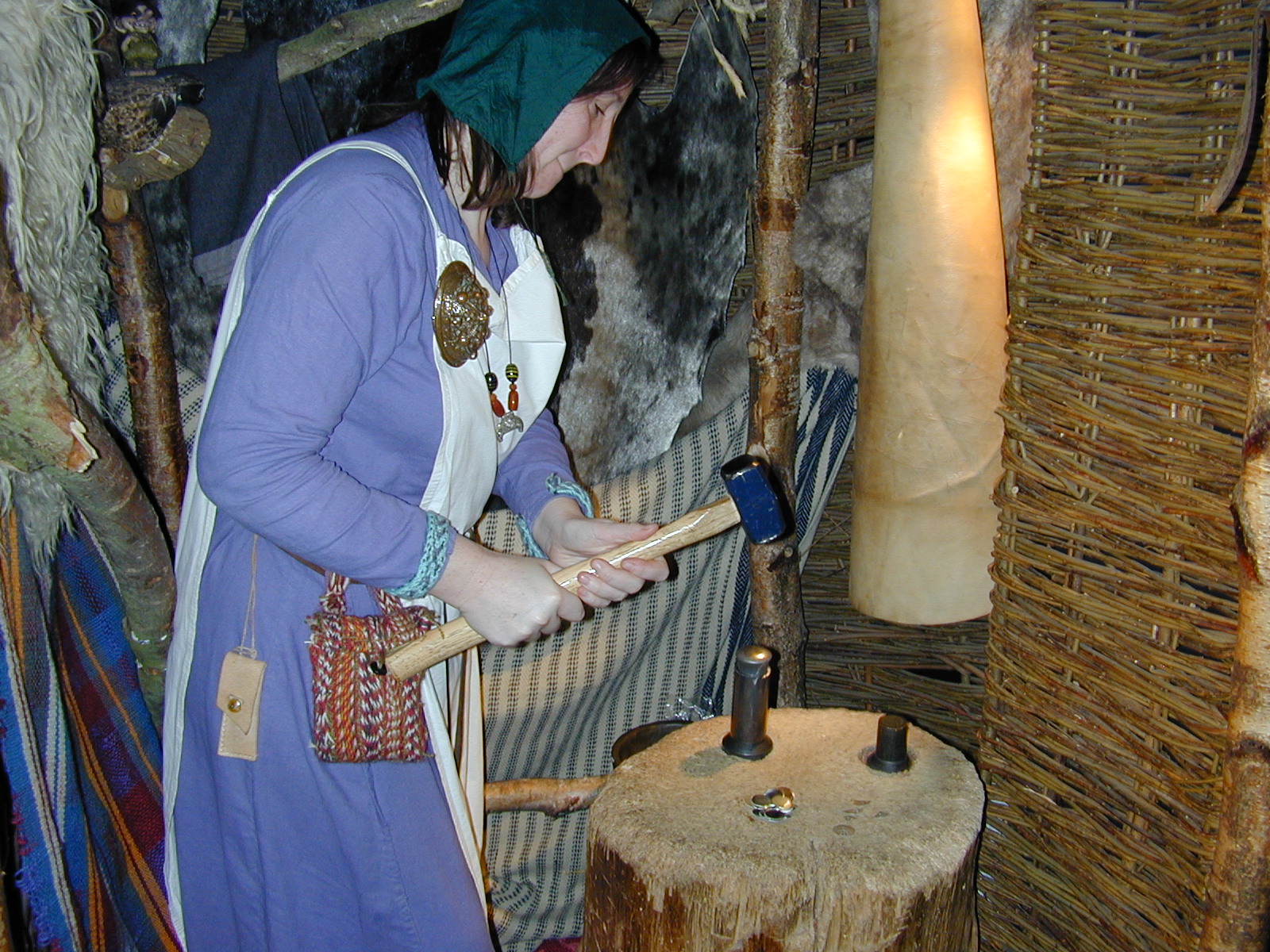Jorvik Viking Centre on:
[Wikipedia]
[Google]
[Amazon]
 The Jorvik Viking Centre is a
The Jorvik Viking Centre is a
 In the 1850s confectioner Thomas Craven acquired a site in
In the 1850s confectioner Thomas Craven acquired a site in

 In 2001, the centre was refurbished and enlarged at a cost of £5 million, and a further investment of £1 million followed in February 2010. These investments were used to "intensify the message" at Jorvik, and included such changes as extending the ride time to 12 minutes, as well as adding more high-tech elements, which included a hike in "the technology and animation elements," and increasing "the sensory stimuli to include smells, more sounds, heat, cold and damp." Visitors are taken back to 5:30 pm 25 October 975 AD in a time-capsule, and then embark on a tour of a reconstructed Viking settlement which includes voices speaking in
In 2001, the centre was refurbished and enlarged at a cost of £5 million, and a further investment of £1 million followed in February 2010. These investments were used to "intensify the message" at Jorvik, and included such changes as extending the ride time to 12 minutes, as well as adding more high-tech elements, which included a hike in "the technology and animation elements," and increasing "the sensory stimuli to include smells, more sounds, heat, cold and damp." Visitors are taken back to 5:30 pm 25 October 975 AD in a time-capsule, and then embark on a tour of a reconstructed Viking settlement which includes voices speaking in 
 The Jorvik Viking Centre is a
The Jorvik Viking Centre is a museum
A museum ( ; plural museums or, rarely, musea) is a building or institution that cares for and displays a collection of artifacts and other objects of artistic, cultural, historical, or scientific importance. Many public museums make thes ...
and visitor attraction in York
York is a cathedral city with Roman origins, sited at the confluence of the rivers Ouse and Foss in North Yorkshire, England. It is the historic county town of Yorkshire. The city has many historic buildings and other structures, such as a ...
, England, containing lifelike mannequins and life-size dioramas depicting Viking life in the city. Visitors are taken through the dioramas in small carriages equipped with speakers. It was created by the York Archaeological Trust
The York Archaeological Trust for Excavation and Research Limited (YAT) is an educational charity, established in 1972 in the city of York, England. It carries out archaeological investigations, fieldwork, excavation and research in York, Yo ...
and opened in 1984. Its name is derived from ''Jórvík
Scandinavian York ( non, Jórvík) Viking Yorkshire or Norwegian York is a term used by historians for the south of Northumbria (modern-day Yorkshire) during the period of the late 9th century and first half of the 10th century, when it was do ...
'', the Old Norse
Old Norse, Old Nordic, or Old Scandinavian, is a stage of development of North Germanic dialects before their final divergence into separate Nordic languages. Old Norse was spoken by inhabitants of Scandinavia and their overseas settlemen ...
name for York and the surrounding Viking Kingdom of Yorkshire.
Background
 In the 1850s confectioner Thomas Craven acquired a site in
In the 1850s confectioner Thomas Craven acquired a site in Coppergate
Coppergate is a street in the city centre of York, in England. The street runs north-east from the junction of Castlegate, Nessgate, King Street and Clifford Street, to end at the junction of Pavement, Piccadilly, Parliament Street and High ...
. When he died in 1862 his widow Mary Ann Craven continued the business and a century later, in 1966, Cravens relocated to a new factory on the outskirts of the city. Between 1976 and 1981, after the old factory was demolished, and prior to the building of the Coppergate Shopping Centre
Coppergate Shopping Centre is a shopping centre in York in North Yorkshire, England. It is named after Coppergate, one of York's medieval streets ("gate" coming from the Old Norse ''gata'', or street).
History
Prior to the development of the ...
(an open-air pedestrian shopping centre which now occupies the enlarged site), the York Archaeological Trust, a charity founded in 1972 by Peter Addyman, conducted extensive excavations
In archaeology, excavation is the exposure, processing and recording of archaeological remains. An excavation site or "dig" is the area being studied. These locations range from one to several areas at a time during a project and can be condu ...
in the area. Well-preserved remains of some of the timber
Lumber is wood that has been processed into dimensional lumber, including beams and planks or boards, a stage in the process of wood production. Lumber is mainly used for construction framing, as well as finishing (floors, wall panels, w ...
building
A building, or edifice, is an enclosed structure with a roof and walls standing more or less permanently in one place, such as a house or factory (although there's also portable buildings). Buildings come in a variety of sizes, shapes, and fu ...
s of the Viking
Vikings ; non, víkingr is the modern name given to seafaring people originally from Scandinavia (present-day Denmark, Norway and Sweden),
who from the late 8th to the late 11th centuries raided, pirated, traded and se ...
city of Jorvík were discovered, along with workshop
Beginning with the Industrial Revolution era, a workshop may be a room, rooms or building which provides both the area and tools (or machinery) that may be required for the manufacture or repair of manufactured goods. Workshops were the on ...
s, fence
A fence is a structure that encloses an area, typically outdoors, and is usually constructed from posts that are connected by boards, wire, rails or netting. A fence differs from a wall in not having a solid foundation along its whole length.
...
s, animal pens, privies, pits and well
A well is an excavation or structure created in the ground by digging, driving, or drilling to access liquid resources, usually water. The oldest and most common kind of well is a water well, to access groundwater in underground aquifers. The ...
s, together with durable materials and artefacts of the time, such as pottery
Pottery is the process and the products of forming vessels and other objects with clay and other ceramic materials, which are fired at high temperatures to give them a hard and durable form. Major types include earthenware, stoneware and ...
, metalwork
Metalworking is the process of shaping and reshaping metals to create useful objects, parts, assemblies, and large scale structures. As a term it covers a wide and diverse range of processes, skills, and tools for producing objects on every scale ...
and bone
A bone is a rigid organ that constitutes part of the skeleton in most vertebrate animals. Bones protect the various other organs of the body, produce red and white blood cells, store minerals, provide structure and support for the body, ...
s. Unusually, wood
Wood is a porous and fibrous structural tissue found in the stems and roots of trees and other woody plants. It is an organic materiala natural composite of cellulose fibers that are strong in tension and embedded in a matrix of lignin ...
, leather
Leather is a strong, flexible and durable material obtained from the tanning, or chemical treatment, of animal skins and hides to prevent decay. The most common leathers come from cattle, sheep, goats, equine animals, buffalo, pigs and hog ...
, textile
Textile is an umbrella term that includes various fiber-based materials, including fibers, yarns, filaments, threads, different fabric types, etc. At first, the word "textiles" only referred to woven fabrics. However, weaving is not the ...
s, and plant and animal remains from the period around 900 AD, were also discovered to be preserved in oxygen-deprived wet clay
Clay is a type of fine-grained natural soil material containing clay minerals (hydrous aluminium phyllosilicates, e.g. kaolin, Al2 Si2 O5( OH)4).
Clays develop plasticity when wet, due to a molecular film of water surrounding the clay par ...
. In all, over 40,000 objects were recovered.
The trust recreated the excavated part of Jorvik on the site, peopled with figures, sounds and smells, as well as pigsties, fish market
A fish market is a marketplace for selling fish and fish products. It can be dedicated to wholesale trade between fishermen and fish merchants, or to the sale of seafood to individual consumers, or to both. Retail fish markets, a type of wet ma ...
and latrine
A latrine is a toilet or an even simpler facility that is used as a toilet within a sanitation system. For example, it can be a communal trench in the earth in a camp to be used as emergency sanitation, a hole in the ground ( pit latrine), or ...
s, with a view to bringing the Viking city fully to life using innovative interpretative methods. The Jorvik Viking Centre, which was designed by John Sunderland, opened in April 1984. Since its formation, the centre has had close to 20 million visitors.
Today

 In 2001, the centre was refurbished and enlarged at a cost of £5 million, and a further investment of £1 million followed in February 2010. These investments were used to "intensify the message" at Jorvik, and included such changes as extending the ride time to 12 minutes, as well as adding more high-tech elements, which included a hike in "the technology and animation elements," and increasing "the sensory stimuli to include smells, more sounds, heat, cold and damp." Visitors are taken back to 5:30 pm 25 October 975 AD in a time-capsule, and then embark on a tour of a reconstructed Viking settlement which includes voices speaking in
In 2001, the centre was refurbished and enlarged at a cost of £5 million, and a further investment of £1 million followed in February 2010. These investments were used to "intensify the message" at Jorvik, and included such changes as extending the ride time to 12 minutes, as well as adding more high-tech elements, which included a hike in "the technology and animation elements," and increasing "the sensory stimuli to include smells, more sounds, heat, cold and damp." Visitors are taken back to 5:30 pm 25 October 975 AD in a time-capsule, and then embark on a tour of a reconstructed Viking settlement which includes voices speaking in Old Norse
Old Norse, Old Nordic, or Old Scandinavian, is a stage of development of North Germanic dialects before their final divergence into separate Nordic languages. Old Norse was spoken by inhabitants of Scandinavia and their overseas settlemen ...
, as well as aromas and "life-like animated figures, made by laser technology from skeletons found on the site." Beyond this is an extensive museum area, which combines an exhibition of some 800 finds from the site with interactive displays and the opportunity to learn about tenth-century life and to discuss it with "Viking" staff. Among the exhibits is a replica of the Coppergate Helmet
The Coppergate Helmet (also known as the York Helmet) is an eighth-century Anglo-Saxon helmet found in York, England. It was discovered in May 1982 during excavations for the Jorvik Viking Centre at the bottom of a pit that is thought to have on ...
, which was found near the site of the centre and is now in the Yorkshire Museum
The Yorkshire Museum is a museum in York, England. It was opened in 1830, and has five permanent collections, covering biology, geology, archaeology, numismatics and astronomy.
History
The museum was founded by the Yorkshire Philosophical Soc ...
. The third incarnation of Jorvik was opened on 13 February 2010, coinciding with the start of the annual Viking Festival in York. The attraction was completely rebuilt following devastating flooding in December 2015, re-opening on 8 April 2017 with the Return of the Vikings.

Jorvik Viking models
Graham Ibbeson created the lifelike mannequins used in the Jorvik experience. At first the faces of these mannequins were modelled from modern day people. However, through advances in facial reconstruction technology eight new mannequins have now been modelled on skulls found in a Viking age cemetery, although there is no guarantee that the skulls were Norse, and there is the possibility that they were Saxon.Viking Festival
The centre also organizes an annual Viking Festival that takes place in the second week of February. The festival is set up in tradition of an ancient Viking festival known as "Jolablot". The festival includes Combat re-enactment involving volunteers from all over the world."Time Warp" experience
Jorvik Viking Centre is not billed as a museum but as an "experience"; this type of educational representation of the past, known as a "Time Warp" experience, has become increasingly popular with the creation of Jorvik. It inspired other such sites as the "Canterbury Pilgrims Way" where visitors can join Geoffrey Chaucer's pilgrimage.2015 flood damage
The centre was significantly affected by the flooding in Northern England in December 2015 with extensive water damage to the building and exhibits. The most valuable Viking artefacts were moved to prevent damage. The museum reopened on 8 April 2017. As part of the redisplay, a new figure of an 'Arab' was introduced to the experience.Public response
The Jorvik Viking Centre has been called "''one of Britain's most popular attractions.''" The BBC spoke of the "Time Warp" experience as "a new art form". The Jorvik Centre has been criticized as a "pop-up book view of history" and its presentation of the past has been labelled "Disney-like". Anthony Gaynor, one of the creators of the centre, responded by stating: "We're making history accessible and enjoyable to the general public. You can't do that if you wrap it in a lot of academic foliage."See also
* The Lloyds Bank coprolite is exhibited there.Notes
*References
*Further reading
*External links
* {{authority control Anglo-Norse England Archaeological sites in North Yorkshire Archaeological museums in England Museums in York Viking Age museums Living museums in England Museums established in 1984 1984 establishments in England York Archaeological Trust Coppergate